John Jasperse presents a new work at BAM Harvey, September 21-24.
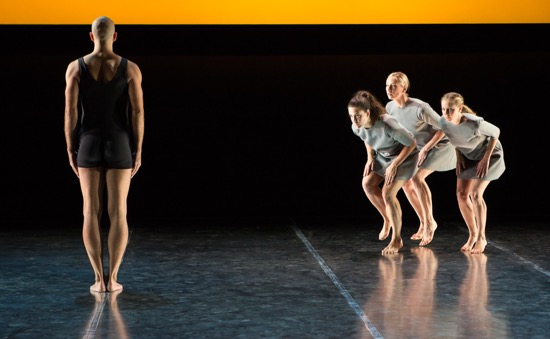
John Jasperse’s Remains. (L to R): Burr Johnson, Claire Westby, Heather Lang, and Maggie Cloud. Photo: Yi-Chun Wu
John Jasperse’s new Remains has a clarity so exquisite that images from it have pasted themselves into my memory. The piece, which premiered at the BAM Harvey this past week, shows some of these images to us many times, but in different ways; imagine a painted group scene, from which someone has clipped individual figures and re-positioned them in relation to one another. By “remains,” Jasperse, I think, is referring not just to leftovers, but to visions and experiences that wander among our recollections.
He has said in an interview with Gia Kourlas that bits and pieces from his own previous works have been used in Remains, as well as references to other choreographers. But you can also see iconic images from art works—notably Botticelli’s The Three Graces and the countless pietàs of Renaissance art. The resulting dance is so gripping that I scarcely change my position during the hour that it lasts.
Lenore Doxsee’s remarkable illumination mixes light and shadow in arresting combinations, with one single, high, pinpoint lamp appearing and disappearing intermittently like a star beset by clouds. It is her lighting that changes the color of the horizontal band suspended above the back wall of the stage and the one close to the floor stage left; sometimes they’re yellow, sometimes apricot, sometimes red.
The aural landscape is equally spare and changeable. John King has created a score pitted by silences (additional music: Javier Peral and Die Antwoord). A high sound may vibrate over a low throbbing. A muttering may succeed a metallic crash and the rumble beneath it. A sweet tumult may arise, or a jangle, or a rhythmic thudding.
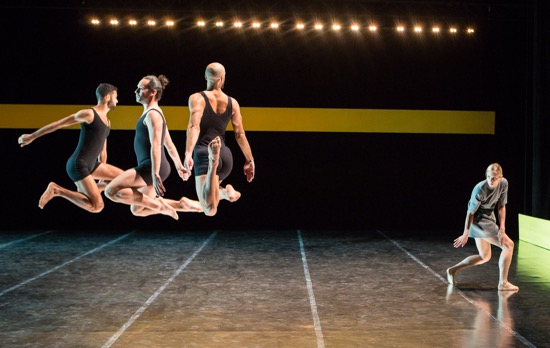
(L to R): Marc Crousillat, Stuart Singer, Burr Johnson, and Heather Lang in John Jasperse’s Remains. Photo: Yi-Chun Wu
Six dancers populate this pristine world: Maggie Cloud, Marc Croussillat, Burr Johnson, Heather Lang, Stuart Singer, and Claire Westby. For a while, the women wear short, sack-like dresses, but eventually all are dressed in full-cut shorts and trim tops in red, white, gray, or black (costumes by Baille Younkman).
From the beginning, Remains announces a timing that quiets your expectations and your heartbeat. The entering audience can already—barely— make out a figure lying motionless, a small island in the center of the very dimly lit stage. Eventually, the house is almost full, but not dark; after the turn-off-cell-phone announcement, everyone falls silent. Then we wait. And wait, noting that the figure onstage is becoming minimally discernible. The ushers seat a few latecomers and, on a signal, disperse. Now in the silence, we see a small miracle. In the muted beam of light, the figure onstage—lying on its side, one leg crossed over the other, its face hidden—begins to glitter with tiny, erratic points of light. What had seemed like a discarded object becomes a treasure.
As the light onstage brightens and the theater darkens, the mystery fades. The object is Maggie Cloud, and sparkles are scattered over her short white smock. She stirs into movement slowly, like an animal coming out of hibernation, turning her head, lifting the lower half of the leg that’s pinned down by its mate until its toes point skyward, sitting up, then reclining like an alluring odalisque, then contracting her rib cage and opening her mouth in a soundless howl. And when the sound score enters discreetly, and others begin to walk across the stage, she repeats her entire awakening.
In part because of the sparseness of Remains, every action seems important—for instance, the fact that when Singer and Johnson cross the stage together, Singer brushes his foot against the floor before taking a step, while Johnson walks steadily on tiptoe. We begin to identify a pointing index finger as a motif; it calls our attention to something or to nothing. Once Lang, straightening herself out of a crone’s huddled-over stance (another re-appearing pose), raises a hand with slightly curled fingers, in that “Verily I say unto you” gesture familiar in Christian iconography.
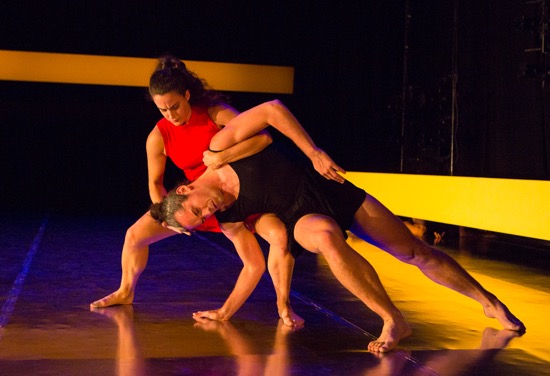
Claire Wesby holds Stuart Singer in Remains. Photo: Yi-Chun Wu
The recurring image of a pietà alters subtly every time we see it. Jasperse has combined it with those depicting Christ’s descent from the Cross. One person stands behind another and sliding his/her hands under the other’s armpits, slowly lowers this collapsing person to drape across her/his knee or lap. A third dancer, close to them, observes. The first time it is seen, the three women repeat the action time after time, all the while traveling across the stage, until the moving tableau disappears into the wings. In one of the iterations, the person being lowered is stiffer, almost doll-like. In another version that arises out of temporary mayhem—with people rushing at each other and being lifted and then dropped to run again—two trios repeat the sequence in unison. As they reach the wings, the horizontal bar must have risen slightly, but after they have crawled beneath it, one person’s leg remains visible for a long time.
In another, very different allusion to this image and to mothers and children in general, the music turns sweetly tumultuous, and after Lang has raised her hand in that annunciatory way, Singer and she lay their heads together and touch hands in curiously awkward ways. Then she sits, legs spread, and he, seated between them reaches up to touch her cheek. Meanwhile, behind them, Crousillat and Johnson continue a pattern of poses (looking into the palms of their hands, laying clasped hands against one cheek. . .).
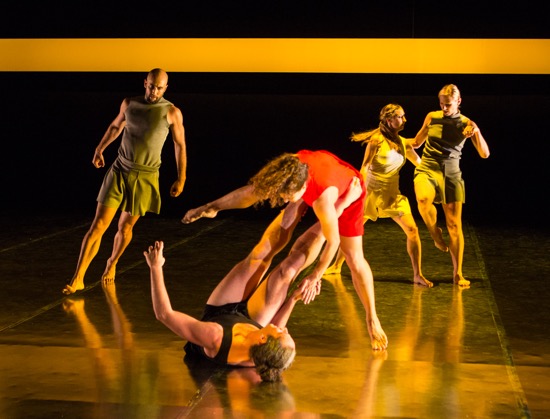
John Jasperse’s Remains. (L to R): Burr Johnson, Stuart Singer, Claire Westby, Maggie Cloud, and Heather Lang. Photo: Yi-Chun Wu
Remains, however, is not a dance you try to interpret. You experience it as a finely engineered collage of penetrating visions dislocated from their sources and constantly repositioned. One of which sources may be Jasperse’s own trove of experiences (such as the classes in Martha Graham’s technique that he took years ago and found unsuited to his body). Some images are complex and others fleeting. But all are so compellingly designed and performed that you don’t wonder why Johnson suddenly jumps and, landing heavily, pats his hands loudly against his spread-apart thighs, or why he stands still and quivers his legs in that familiar cliché for terror. Or why the women, at one point moving across the stage together, lift up their knees and stomp their feet down hard as they go.
One image may bleed into another with no loss of clarity. And that clarity makes the modulations stand out. The women holding hands in a ring do not seem to let that fact turn into a graceful twining the way the men do when, much later, they find themselves in the same formation. Our own views quickly turn into recollections, as we notice, say, a reference to Cloud’s opening pose by Singer, Crousillat, and Cloud herself in another context.
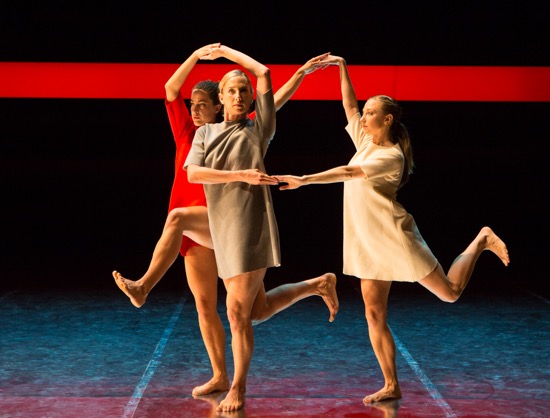
Three Graces (L to R): Claire Westby, Heather Lang, and Maggie Cloud. Photo: Yi-Chun Wu
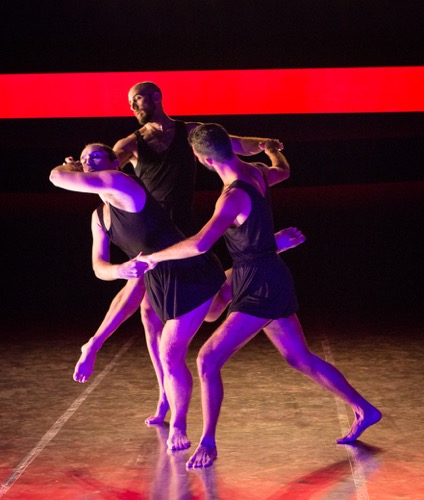
Three Graces (L to R): Stuart Singer, Burr Johnson, and Marc Crousillat. Photo: Yi-Chun Wu
For a long time near the end of Remains, the dancers walk together in various patterns: lines weaving in and out of each other, lines crossing and changing directions, braiding together (do I hear an accordion? A ¾ tune?). It’s a calming period, before wildness breaks out again, and the music stops abruptly, the lights get bright, and most of the dancers carry or drag one each other offstage. The pace and complexity, and dancerly vigor seem to increase steadily, despite the slow or quiet interludes, repetitions. Remembered moments drop in like leaves and blow away. New vignettes pop up too, one of which has an element of drama. Cloud, screwing up her face into mean determination, “kills” Westby, as others back away, then lies prone on top of her victim. Westby recovers after her attacker leaves, but seems weaker as she dances (she conveys this wonderfully well). In the end, they are all walking, some on individual paths, obeying the choreographer’s recorded voice, as it directs them to step forward or back (Crousillat is crawling on the points of his knees, his feet off the floor!). This goes on for a long time. But now all the performers are wearing sparkling, even dazzling, outfits, and eventually some seem to disobey the commands—or perhaps they just don’t interpret them accurately.
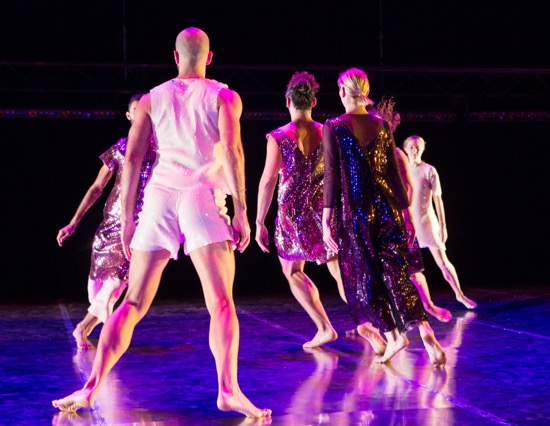
A final image from John Jasperse’s Remains. (L to R): Marc Crousillat (half-hidden), Burr Johnson, Stuart Singer, Heather Lang, Claire Westby (hair only), and Maggie Cloud. Photo: Yi-Chun Wu
I don’t think they’ve died and gone to heaven, nor does the gleaming attire turn them into stars, but, as in the initial sight of Cloud, the clothing seems to make them burn brighter, scalding them into our memories. Although, of course, these highly skilled performers, sensitive to nuances of behavior, have already done that.

Geography being what it is, I hardly ever see Jasperse’ work — many thanks for bringing a part of it here, so that I can get a sense of what happens there.
What a beautiful, eloquent piece, Deborah, thank you so much. I too have seen little of Jasperse’s work, but still hold some imagery from what I have seen in the back of my aging brain, an extremely visual artist I think.